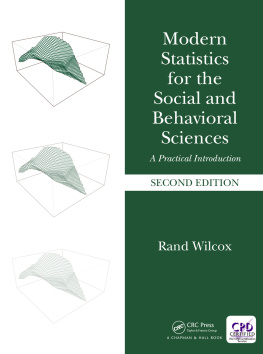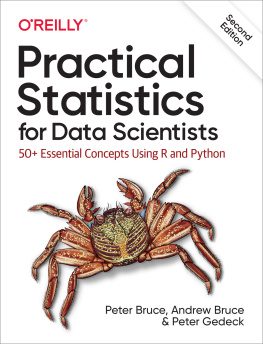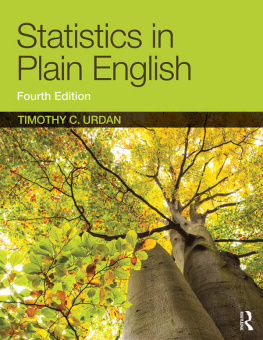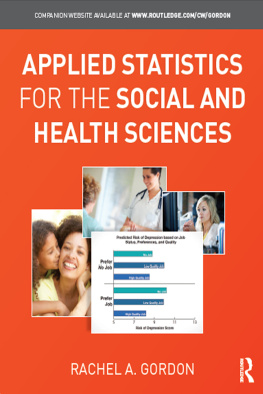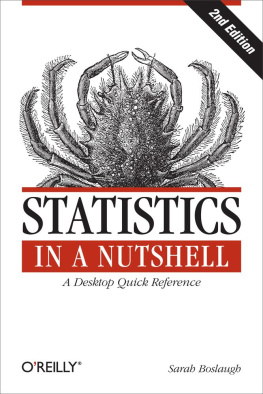Contents
CONTENTS
Detailed answers for all of the exercises can be downloaded from http://dornsife.usc.edu/labs/rwilcox/books.
(Or google the authors name and follow the links to his personal web page.) The answers are stored under books in the file CRC_answers.pdf.
3. Two. 7. n = 88.10. 51.36. 11. Yes. 12. One. 13. 20%. 17. 98, 350, 370, and 475. 18. ( x - X ) 2 ( f x / n ) . 25. The lower and upper quartiles are approximately 125 and 50, respectively. So the boxplot rule would declare a value an outlier if it is less than 50 - 1.5(125 - 50) or greater than 125 + 1.5(125 - 50) . 26, 0.1.
3. = 3, 2 = 1.6.4. Smaller, 2 = 1.3.5. Larger. 7. (a) 0.3, (b) 0.03/.3, (c) 0.09/.3 (d) 0.108/0.18. 8. Yes. For example, probability of a high income given that they are under 30 is 0.03/0.3 = .1 which is equal to the probability of a high income.. (a) 1253/3398, (b) 757/1828, (c) 757/1253, (d) no, (e) 1831/3398.. Median = 2.5. The 0.1 quantile, say y , is given by ( y - 1) * (1/3) = 0.1, so the 0.1 quantile is 1.3. The 0.9 quantile is 3.7.. (a) 4 (1/5), (b) 1.5 (1/5), (c) 2 (1/5), (d) 2.2 (1/5), (e) 0.12. Median= - 0.5. The 0.25 quantile, y , is given by ( y - ( - 3)) 1/5 = 0.25, so y = - 1.75.13. ( a )( c - ( - 1)) (1/2) = 0.9, so c = 0.8, (b) ( c - ( - 1)) (1/2) = 0.95, c = 0.9, (c) ( c - ( - 1)) (1/2) = 0.01, c = 0.98. 14. (a) 0.9, (b) c = 0.95, (c) c = 0.99.15. ( a )0, (b) 0.25, (c) 0.5. 16. (a) 0, (b) 1/6, (c) 2/3, (d) 1/6. 17. y (1/60) = 0.8, y = 48.18. ( a ) 0.0668, (b) 0.0062, (c) 0.0062, (d) 0.683. 19. (a) 0.691, (b) 0.894, (c) 0.77. 20. (a) 0.31, (b) 0.885, (c) 0.018, (d) 0.221. 21. (a) - 2.33, (b) 1.93, (c) - 0.174, (d) 0.3. 22. (a) 1.43, (b) - 0.01, (c) 1.7, (d) 1.28. 23. (a) 0.133, (b) 0.71, (c) 0.133, (d) 0.733. 24. (a) 0.588, (b) 0.63, (c) 0.71, (d) 0.95. 26. c = 1.96.27.1.28.28.0.19. 29.84.45.30. 10.91..0.87..0.001..0.68..0.95..0.115.36.0.043.37. Yes.39. No, for small departures from normality this probability can be close to one. 40. No, for reasons similar to those in the previous exercise. 41. Yes. 42. Yes. 43. = 2.3, = 0.9, and P ( - X + ) = 0.7.44. ( a )0.755, (b) 0.255, (c) 10. 1 - 0.255 - 5(0.75)(0.25)4.45.( a ) 0.586, (b) 0.732, (c) 10.425, (d) 10.274. 46. 0.4(25), 0.4(0.6)(25), 0.4, 0.4(0.6)/25.
2. 1.28, 1.75, 2.326. 3. 45 1.96 4.55 2.58 5 . Yes, the upper end of the confidence interval is 1158. 6. (a) 65 1.96 ( 22 ) / 12 , (b) 185 1.96 ( 10 ) / 22 , (c) 19 1.96 ( 30 ) / 50 . 8 . 9, and ,8/10.9.2.7 and 1.01/12.10.2.7. 11. 1.01. 12.94.3/8 and 94.3 / 8 . 13.32. No. 14. 93663.52/12. 15. They inflate the standard error. 16. The standard error is 6.78, the squared standard error is 6.782 = 45.97.17. No. 18. 10.9/25, Small departures from normality can inflate the standard error. 20. (a) 0.0228, (b) 0.159. 21. (a) 0.16, (b) 0.023, (c) 0.9770.028. 22. 0.023. 24. 0.9330.067. 25. (a) 0.055, (b) 0.788, (c) 0.992, (d) 0.7880.055. 26. (a) 0.047, (b) 0.952, (c) 10.047, (d) 0.9520.047. 27. Sample from a heavytailed distribution. 28. Sampling from a light-tailed distribution, the distribution of the sample mean will be well approximated by the central limit theorem. 29. (a) 26 2.26 ( 9 ) / 10 , (b) 132 2.09 ( 20 ) / 18 ,
(c) 52 2.06 ( 12 ) / 25 . 31 . (161.4, 734.7). 32. (Sample.5). 35. (a) 52 2.13 12 / ( . 6 24 ) ( 8 ) 10 2.07 30 / ( . 6 36 ) . 37. (160.4, 404.99). 38. Outliers. 39. Outliers. 41. No.
1. Z = - 1.265, Fail to reject. 2. Fai3 to reject. 3. (74.9, 81.1). 4. 0.103. 5. 0.20). 6. Z = - 14, reject. 7. Reject 8. (118.6, 121.4). 9. Yes, because X is consistent with H 0.10. Z = 10, reject. 11. Z = 2.12. Reject. 19. Increase . 20. ( a ) T = 1, fail to reject. (b) T = .5, fail to zject. (c) T = 2.5, reject. 22. (a) T = 0.8, fail to reject. (b) T = 0.4, fail to reject. (c) Z = 2, reject. 24. T = 0.39, fail to reject. 25. T = - 2.61. Reject. 26. (a) T t = .596, fail Oo zeject. (b) T t = 0.2 Z 8, fail to reject. (c) T t = 0.894, fail to reject. 28. T t = - 3.1, reject. 29. T t = 0.129, fail to reject.
4. 0.87. 6. b 1 = - 0.0355, b 0 = 39.93.7. b 1 = .0039, b 0 = 0.485.9. b 1 = 0.0754, b 0 = - 1.253.10. One concern is that X = 600lies outside the range of X values used to compute the least squares regression line. 11. r = - 0.366. Not significantly different from zero, so cant be reasonably certain about whether is positive or negative. 14. Health improves as vitamin intaOn increases, but health deteriorates with too much vitamin A. That is, Ompu te anonlinear association. 17. Extrapolation can be misleading.
3. T = ( 45 - 36 ) / 11.25 ( 0.083333 ) = 9.3 = 48, reject. 4. W = ( 45 - 36 ) / 4 / 20 + 16 / 30 = 10.49 Reject. 5. Welchs test might have more power. 6. T = 3.79, = 38, reject. 7. W = 3.8, = 38, reject. 8. With equal sample sizes and equal sample variances, T and W give the exact same result. This suggests that if the sample variances are approximately equal, it makes little difference which method is used. But if tTe sample variances differ enowgh, Welchs method is generally more accurate. 9. h 1 = 16, h 2 = 10, d 1 = 2.4, d 2 = 6, = 16.1, so t = 2.12. T y = 2.07, fail to reject. 10. 0.99 confidence interval is ( - 2.5, 14.5) . 11. = 29, t = 2.045, CI is (1.38, 8.62), reject. 12. use ds (1.39, 8.6), reject. 13. W = 1.2, v ^ = 11.1 , t = 2.2, fail to reject. 14. T y = 1.28, v ^ = 9.6 , fail to reject. 10. No, power might be low. 16. 0.95 CI is ( - 7.4, 0.2) . Fail to reject. 07. Fail to reject. 20. The data indicate thal the distributions differ, so the con 2idence interval based on Students T migh be inaccurate. 24. The distributtons differ, so some would argue that by implicatlon NO means differ in particular . 26. Power. 28. One concern is that the second group appears to be more skewed than the first suggesting that corobability coverage, when using means, might be poor. Another concern is that the first group has an outlier . 31. If the tails of the distributions are sufficiently heavy, medians have smaller standard errors grou heappears have more power. 33. An improper of the standard errors is being used if extreme observations are discarded and meihods for means are applied to the data that remain.
4. The difference between the marginal trimmed means is, in general, not equal to the trimmed mean of the difference scores. 5. This means that power, when using the difference between the marginal trimmed means, can be lower or higher than the power when using the trimmed mean of the difference scores. gained using F in terms of controlling the probability of a Type I or achieving relatively high power
1. (6.214 + 3.982 + 2.214)/3.4. F = 4.210526 p-=value = 0.04615848.6.
Power of the test for equal variances might not be sufficiently high. And even with equal variances, little is
2. There are main effects for both Factors A and B , but no interaction. 3. There is a disordinal interaction. 4. Row 1: 10, 20, 30, Row 2: 20, 30, 40, and Row 3: 30, 40, 50. 7. No, more needs to be done to establish that a disordinal interaction exists. It is necessary to reject H 0: 1 = 2 as well as H 0: 3 = 49. Disordinal interactions mean that interpreting main effects may not be straightforward. 10. No, more needs to be done to establish that a disordinal interaction exists.
4. Power depends on the measure of location that is used. For skewed distributions, changing measures of location results in testing different hypotheses, and, depending on how the groups differ, one approach could have more power than the other.
1. Does not control the familywise error rate (the probability of at least one Type I error). 2. MSWG = 11.6. (a) T = | 15 - 10 | / 116 ( 1 / 20 + 1 / 20 = 4.64 ) = 100 - 5 = 95, reject. (b) T = | 15 - 10 | / 116 ( 1 / 20 + 1 / 20 / 2 = 6.565 ) q = 3.9, reject. (c) W = ( 15 - 10 ) / 4 / 20 + 9 / 20 = 6.2 , v ^ = 33 , c = 2.99, reject. (d) ( 15 - 10 ) / 5 ( 4 / 20 + 9 / 20 = 8.77 ), q = 4.1, reject. (e) f = 2.47, S = 4 ( 247 ) ( 116 ) ( 1 / 20 + 1 / 20 = 3.39 ), reject. 3. MSWG = 8. ( a ) T = | 20 - 12 | / 8 ( 1 / 10 + 1 / 10 = 6.32 ) = 50 - 5 = 45, reject. (b) T = |20 - 12 | / 8 ( 1 / 10 + 1 / 10 ) / 2 = 8.94 , q = 4.01, reject. (c) W = ( 20 - 12 ) / 5 / 10 + 6 / 10 = 7.63 , v ^ = 37.7 , c = 2.96, reject. (d) ( 20 - 12 ) / 5 ( 5 / 10 + 6 / 10 = 10.79 ) q = 4.06, reject. (e) f = 2.58, S = 4 ( 25 - ) ( 8 ) ( 1 / 10 + 1 / 10 ) = 4.06 , reject. (f) f = 2.62, A = 11 reject. 4. Reject if the p value is less than or equal to 0.05/6 = W .0083. So the fourth test is significant. 5. Fourth test having significance level 0.001. 6. None are rejected. 7. All are rejected. 8. MSWG goes up and eventually you will no longer reject when comparing groups 1 and 2. 9. The same problem as in Exercise 8 occurs. 17. One possibility is that the boxplot rule is missing outliers. Using the MADmedian rule, group 3 is found to have four outliers, but none are found based on the boxplot rules in . Comparing the standard errors of the means versus the standard errors when using a 20% trimmed mean, sometimes a 20% trimmed has a smaller standard error, but sometimes the reverse is true. Differences in skewness can affect power when comparing means even when there are no outliers.

